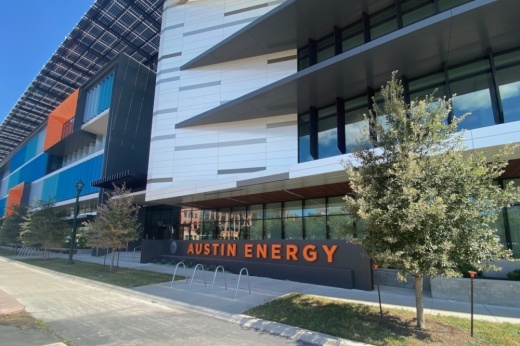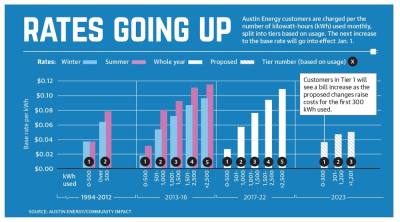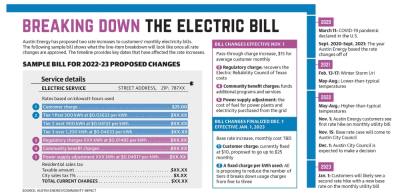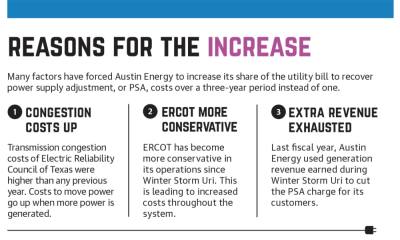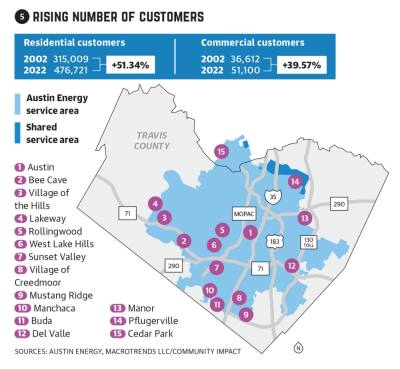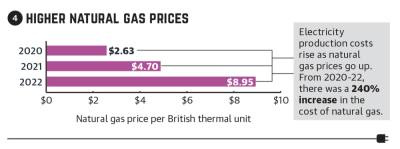Austin Energy is passing these charges to the customers as a result of factors that were beyond its control, inflation, and rising cost of basic maintenance and operation, according to AE documents from April.
Austin City Council approved an increase to the pass-through charge Oct. 13, effective Nov. 1 for customers. The bill represents a $15 monthly increase for the average AE customer.
The second rate increase under consideration is for the base rate and customer charge, which usually undergo revision every five years. If approved as proposed, this could add up to another $15.56 to customer bills monthly starting in January.AE officials said the public utility needs these increases to balance rising inflation and infrastructure costs as well as offset customers reducing their energy usage. These conservation efforts are causing a budget shortfall for the utility company.
While AE officials say the causes for rate increases are outside of their control, the sudden rate hikes have left questions about why AE waited so long to voice concerns about cost recovery.
“There’s going to be a lot of people that don’t know this is coming,” said Paul Robbins, a consumer advocate who has participated in the city of Austin discussions.
Explaining the charges
The rate raises in question include the pass-through charge that is approved annually and was reflected on bills starting in November.
The pass-through charges add an approximately $15 monthly increase for three years to the average residential customer. There are three main components of pass-through charges, including the power supply adjustment, or PSA, that refers to the cost of fuel for power plants and electricity purchased from the grid; the regulatory charge, which recovers the Electric Reliability Council of Texas costs in the electric industry; and the community benefit charge, which funds additional programs and services that provide a benefit to the greater community.
AE was not able to recover $104 million in PSA costs in 2021-22. The utility company kept the pass-through charges at a lower rate than normal in 2021 because it had some funds left from when it sold electricity to ERCOT during Winter Storm Uri. AE officials gave back the added revenue to their customers in the form of a lower-than-normal PSA, according to AE documents. The approximately $15 monthly charge for three years will help the public utility company recover this shortfall, according to an AE spokesperson.
The second increase under consideration is the base rate, which was last reviewed in 2017 and was expected to undergo a review in 2020; however, the COVID-19 pandemic delayed the process. The base rate is composed of the base cost per kilowatt-hour of electricity used and the recurring monthly customer charge.
AE conducts a cost recovery review every few years to ensure that its base rates are sufficiently covering the cost of owning and operating the utility.
In July, AE proposed a 7.6% base rate increase that would cost the average resident $15.56 more on their monthly power bill to bring in $48 million more in annual revenue needed to cover the utility’s budget shortfall. In November, AE’s recalculated budget shortfall amounted to $35 million, and the council is looking at a 5.6% increase to recover the remaining costs, which would cost residents an undetermined amount more monthly. The figure could still change following public meetings later in November, and City Council will sign off on a new base rate Dec. 1, effective Jan. 1 for customers.
When AE started work on reviewing its rates in April, it used 2021 as the test year to show consumption patterns and costs from previous years.
“The rate proposal is built upon a false foundation,” said Bill Oakey, a former member of the city’s electric utility commission.
Documents submitted to City Council by the participants in the review process showed concern that 2021 was abnormal because of Winter Storm Uri, a mild summer and the ongoing pandemic. Although AE normalized the year to reflect average trends, participants said the utility’s efforts were insufficient.
The proposed base rate increase is expected to be much higher for a business or industrial customer, according to NXP, a semiconductor that operates manufacturing facilities in Austin.
As part of the base rate increase, AE’s current proposal would also increase the customer charge 150% from $10 to $25. If approved, this charge would also go into effect Jan. 1.
Environment and climate organization The Sierra Club is part of city discussions and has voiced why it opposes AE’s current proposal that increases the customer charge.
“No matter the amount of energy used or the amount of electricity used, you would still have to pay that $15 increase, which isn’t a good incentive for people to conserve energy,” said Cyrus Reed, conservation director of Sierra Club’s Lone Star chapter.
The journey to now
AE is a publicly owned company that was established in 1895 and serves about 521,000 residential and commercial customers. That number has increased by 80,000 since 2016.
“Our customer base continues to expand as we see steady growth in Austin,” said Matt Mitchell from Austin Energy communications and media relations. “New construction means new demand for energy, and that means added infrastructure costs, [and] that is why it is essential that our base rates cover those rising costs, something that the current rate structure does not.”
AE recently completed the Bluff Springs substation to provide electricity in Southeast Austin, and the Rainey Street substation is set to come online as early as December to support the increase in usage, Mitchell said. Some consumer advocates agree with AE when it comes to updating their infrastructure.
“If you build a new transmission line, you need to pay for it,” Robbins said.
Winter Storm Uri also impacted the new AE rates. ERCOT, which manages the flow of electric power in Texas, has become more conservative in its operations since Winter Storm Uri, according to AE. The state’s changes aimed at grid stability have cost $1.5 billion in 2022, according to AE and the Independent Market Monitor.
AE was also forced to pay an extra $42 million as ERCOT withheld payment to the utility company when Brazos Electric Cooperative in Waco declared bankruptcy after Winter Storm Uri and could not pay ERCOT for power received during the winter storm, according to AE documents.
Additionally, AE operates three natural gas-powered plants in the Austin area. The price of natural gas has also increased due to global factors such as the Ukraine war, supply and demand of the global commodity, and a record hot summer from May to August, Mitchell said.
“When you see a 108% increase year over year in natural gas prices, that is reflective of not just greater demand in Texas, not just greater demand in the United States, but worldwide demand,” Mitchell said.
An additional concern under discussion in the base rate review is the percentage of revenue Austin Energy is required to return to the city’s general fund transfer. The percentage is allocated by elected City Council members and has ranged from $105 million-$114 million in recent years. This funds the police, public safety initiatives, the 311 phone bank and many other services that support the community.
“There has been discussion recently about capping the [general fund transfer] and returning any overage to the utility to offset costs, which could be returned to ratepayers in some way. That would really depend on the circumstances of any given year,” Mitchell said.
Impact on customers
When both rate hikes go into effect, average AE residential customers could be facing up to about $30 more a month on their bills.
Even when Austin City Council adopted the pass-through rate Oct. 13, council members expressed concern over their decision. The resolution passed with three members out of eight voting against it.
“I cannot, in good faith, support Austin Energy’s power supply adjustment. I constantly hear stories from our community members about displacement, rising rents and stagnant paychecks,” District 2 Council Member Vanessa Fuentes said. AE provides relief in the form of its Customer Assistance Program, Plus 1 for financial support and energy efficiency offerings. AE also has account managers who are in contact with businesses to help identify possible energy incentives.
With Austin Water expected to pass increased costs on to customers in 2023, Austin residents could see a rise in other portions of their utility bills in the coming year.
As the base rate is being finalized, City Council, Austin Energy and independent participants in the discussion are working to prevent Austin Energy customers from a similar rate shock in the future and to make sure there is more frequent communication between the public utility company and its users.
“Council and Austin Energy staff are putting in place safeguards that are meant to insulate our ratepayers as much as possible from a spike in power supply adjustment costs [in the future],” Oakey said.




